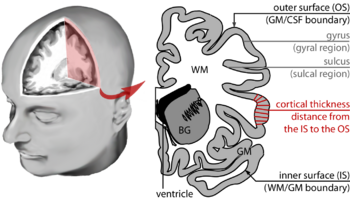User:Daniel Mietchen
I am a biophysicist focusing on the application of methods from physics to the study of biological structures and processes from a comparative evolutionary perspective, with a current emphasis on applications of brain morphometry (e.g. gyrification and cortical thickness) to the study of schizophrenia. My activities at CZ are centred around these matters and sustainable science but other topics of interest to me are listed here, and I also contribute to CZ:Eduzendium (e.g. this summer school). Though I prefer to edit here, I still occasionally do so at the Wikipedias, particularly in areas or languages not covered here yet. More information about me can be found via my lab page, PhD thesis, online book collection, blog, feed, tag cloud and band.
Research areas
![]() Brain morphometry: The quantitative study of structures in the brain, their differences between individuals, correlations with brain function, and changes of these characteristics over time. [e]
Brain morphometry: The quantitative study of structures in the brain, their differences between individuals, correlations with brain function, and changes of these characteristics over time. [e]
Brain morphometry is a subfield of both morphometry and the brain sciences, concerned with the measurement of brain structures and changes thereof during development, aging, learning, disease and evolution. Since autopsy-like dissection is generally impossible on living brains, brain morphometry starts with noninvasive neuroimaging data, typically obtained from magnetic resonance imaging (or MRI for short). These data are born digital, which allows researchers to analyze the brain images further by using advanced mathematical and statistical methods such as shape quantification or multivariate analysis. This allows researchers to quantify anatomical features of the brain in terms of shape, mass, volume (e.g. of the hippocampus, or of the primary versus secondary visual cortex), and to derive more specific information, such as the encephalization quotient, grey matter density and white matter connectivity, gyrification, cortical thickness, or the amount of cerebrospinal fluid. These variables can then be mapped within the brain volume or on the cortical surface, providing a convenient way to assess their pattern and extent over time, across individuals or even between different biological species. The field is rapidly evolving along with neuroimaging techniques — which deliver the underlying data — but also develops in part independently from them, as part of the emerging field of neuroinformatics, which is concerned with developing and adapting algorithms to analyze those data. (Read more...)
Research publications
For full publication list, go here.
- Mietchen, D., Manz, B., Volke, F., Storey, K. B. (2008), "In Vivo Assessment of Cold Adaptation in Insect Larvae by Magnetic Resonance Imaging and Magnetic Resonance Spectroscopy", PLoS ONE 3: e3826, DOI:10.1371/journal.pone.0003826
4964033|100}} {{#ev:vimeo|4964093|100}} {{#ev:vimeo|4964133|100}} {{#ev:vimeo|4964219|100}} {{#ev:vimeo|4964279|100}} {{#ev:vimeo|4964330|100}} {{#ev:vimeo|4964531|100}} {{#ev:vimeo|4964391|100}} {{#ev:vimeo|4964427|100}}
- Mietchen, D.; Aberhan, M.; Manz, B.; Hampe, O.; Mohr, B.; Neumann, C.; Volke, F. (2008), "Three-dimensional Magnetic Resonance Imaging of fossils across taxa", Biogeosciences 5: 25–41
5027279|100}} {{#ev:vimeo|5027286|100}} {{#ev:vimeo|5027287|100}} {{#ev:vimeo|5027288|100}} {{#ev:vimeo|5027290|100}}
- Koelsch, S.; Remppis, A.; Sammler, D.; Jentschke, S.; Mietchen, D.; Fritz, T.; Bonnemeier, H.; Siebel, W. A. (2007), "A cardiac signature of emotionality", European Journal of Neuroscience 26 (11): 3328–3338, DOI:10.1111/j.1460-9568.2007.05889.x
- Koelsch, S.; Jentschke, S.; Sammler, D.; Mietchen, D. (2007), "Untangling syntactic and sensory processing: an ERP study of music perception", Psychophysiology 44 (3): 476–490, DOI:10.1111/j.1469-8986.2007.00517.x
- Lee, S. C.; Mietchen, D.; Cho, J. H.; Kim, Y. S.; Kim, C.; Hong, K. S.; Lee, C.; Kang, D.; Lee, W.; Cheong, C. (2007), "In vivo magnetic resonance microscopy of differentiation in Xenopus laevis embryos from the first cleavage onwards", Differentiation 75 (1): 84–92, DOI:10.1111/j.1432-0436.2006.00114.x
4963736|100}} {{#ev:vimeo|4963816|100}} {{#ev:vimeo|4963838|100}} {{#ev:vimeo|4963886|100}}
- Lee, Seung-Cheol; Cho, Jee-Hyun; Mietchen, Daniel; Kim, Young-Sook; Hong, Kwan Soo; Lee, Chulhyun; Kang, Dongmin; Park, Ki Deok; Choi, Byong-Seok; Cheong, Chaejoon (2006), "Subcellular In Vivo 1H MR Spectroscopy of Xenopus laevis Oocytes", Biophysical Journal 90 (5): 1797–1803, DOI:10.1529/biophysj.105.073502
- Müller, W. E. G.; Kaluzhnaya, O. V.; Belikov, S. I.; Rothenberger, M.; Schröder, H. C.; Reiber, A.; Kaandorp, J. A.; Manz, B.; Mietchen, D.; Volke, F. (2006), "Magnetic resonance imaging of the siliceous skeleton of the demosponge Lubomirskia baicalensis", Journal of Structural Biology 153 (1): 31–41, DOI:10.1016/j.jsb.2005.09.008
- Mietchen, D.; Keupp, H.; Manz, B.; Volke, F., "Non-invasive diagnostics in fossils – Magnetic Resonance Imaging of pathological belemnites", Biogeosciences 2: 133-140
5026838|100}} {{#ev:vimeo|5026939|100}} {{#ev:vimeo|5027060|100}} {{#ev:vimeo|5027100|100}} {{#ev:vimeo|5027102|100}}
- Mietchen, D.; Jakobi, J. W.; Richter, H. P. (2005), "Cortex reorganization of Xenopus laevis eggs in strong static magnetic fields", Biomagn Res Technol 3: 2, DOI:10.1186/1477-044X-3-2
- Mietchen, Daniel; Schnelle, Thomas; Mülller, Torsten; Hagedorn, Rolf; Fuhr, Günter (2002), "Automated dielectric single cell spectroscopy - temperature dependence of electrorotation", Journal of Physics D: Applied Physics 35 (11): 1258–1270, DOI:10.1088/0022-3727/35/11/324
